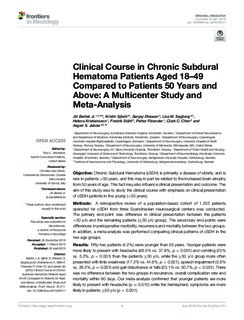| dc.contributor.author | Bartek, Jiri | |
| dc.contributor.author | Sjåvik, Kristin | |
| dc.contributor.author | Dhawan, Sanjay | |
| dc.contributor.author | Sagberg, Lisa Millgård | |
| dc.contributor.author | Kristiansson, Helena | |
| dc.contributor.author | Ståhl, Fredrik | |
| dc.contributor.author | Förander, Petter | |
| dc.contributor.author | Chen, Clark C. | |
| dc.contributor.author | Jakola, Asgeir Store | |
| dc.date.accessioned | 2019-08-07T11:55:18Z | |
| dc.date.available | 2019-08-07T11:55:18Z | |
| dc.date.created | 2019-04-12T19:18:29Z | |
| dc.date.issued | 2019 | |
| dc.identifier.issn | 1664-2295 | |
| dc.identifier.uri | http://hdl.handle.net/11250/2607455 | |
| dc.description.abstract | Objective: Chronic Subdural Hematoma (cSDH) is primarily a disease of elderly, and is rare in patients <50 years, and this may in part be related to the increased brain atrophy from 50 years of age. This fact may also influence clinical presentation and outcome. The aim of this study was to study the clinical course with emphasis on clinical presentation of cSDH patients in the young (<50 years).
Methods: A retrospective review of a population-based cohort of 1,252 patients operated for cSDH from three Scandinavian neurosurgical centers was conducted. The primary end-point was difference in clinical presentation between the patients <50 y/o and the remaining patients (≥50 y/o group). The secondary end-points were differences in perioperative morbidity, recurrence and mortality between the two groups. In addition, a meta-analysis was performed comparing clinical patterns of cSDH in the two age groups.
Results: Fifty-two patients (4.2%) were younger than 50 years. Younger patients were more likely to present with headache (86.5% vs. 37.9%, p < 0.001) and vomiting (25% vs. 5.2%, p < 0.001) than the patients ≥50 y/o, while the ≥50 y/o group more often presented with limb weakness (17.3% vs. 44.8%, p < 0.001), speech impairment (5.8% vs. 26.2%, p = 0.001) and gait disturbance or falls (23.1% vs. 50.7%, p < 0.001). There was no difference between the two groups in recurrence, overall complication rate and mortality within 90 days. Our meta-analysis confirmed that younger patients are more likely to present with headache (p = 0.015) while the hemispheric symptoms are more likely in patients ≥50 y/o (p < 0.001).
Conclusion: Younger patients with cSDH present more often with signs of increased intracranial pressure, while those ≥50 y/o more often present with hemispheric symptoms. No difference exists between the two groups in terms of recurrence, morbidity, and short-term mortality. Knowledge of variations in clinical presentation is important for correct and timely diagnosis in younger cSDH patients. | nb_NO |
| dc.language.iso | eng | nb_NO |
| dc.publisher | Frontiers Media | nb_NO |
| dc.rights | Navngivelse 4.0 Internasjonal | * |
| dc.rights.uri | http://creativecommons.org/licenses/by/4.0/deed.no | * |
| dc.title | Clinical Course in Chronic Subdural Hematoma Patients Aged 18–49 Compared to Patients 50 Years and Above: A Multicenter Study and Meta-Analysis | nb_NO |
| dc.type | Journal article | nb_NO |
| dc.type | Peer reviewed | nb_NO |
| dc.description.version | publishedVersion | nb_NO |
| dc.source.journal | Frontiers in Neurology | nb_NO |
| dc.identifier.doi | 10.3389/fneur.2019.00311 | |
| dc.identifier.cristin | 1692063 | |
| dc.description.localcode | Copyright © 2019 Bartek, Sjåvik, Dhawan, Sagberg, Kristiansson, Ståhl, Förander, Chen and Jakola. This is an open-access article distributed under the terms of the Creative Commons Attribution License (CC BY). | nb_NO |
| cristin.unitcode | 194,65,20,0 | |
| cristin.unitcode | 1920,16,0,0 | |
| cristin.unitname | Institutt for samfunnsmedisin og sykepleie | |
| cristin.unitname | Nevroklinikken | |
| cristin.ispublished | true | |
| cristin.fulltext | original | |
| cristin.qualitycode | 1 | |

